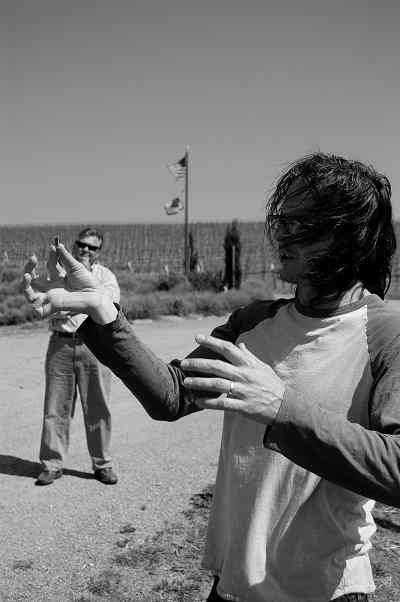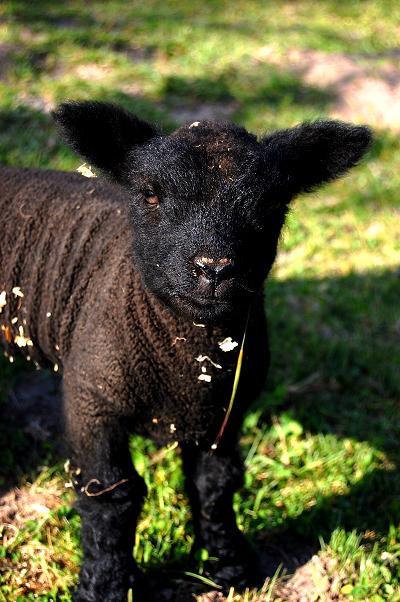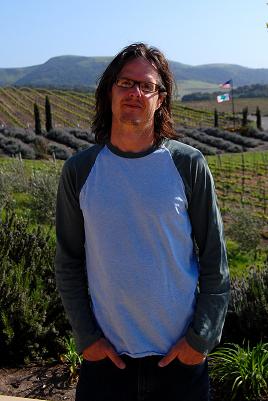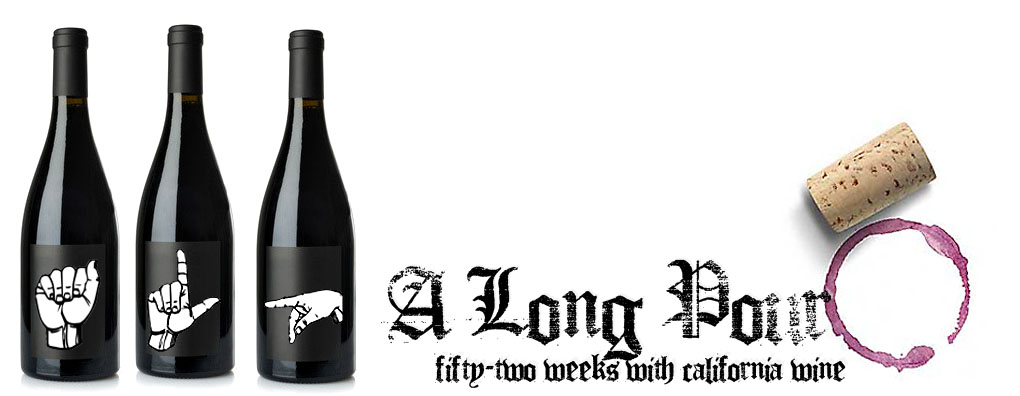Clos Pepe – Battle For the Soul of Pinot
Wes Hagen makes it easy for one to get excited about visiting him at the Sta. Rita Hills vineyard he manages. “Put your thinking cap on,” he told me, “this place may blow your mind,” Sta. Rita Hills has certainly blown his.
The guy is nuts about his little slice of pinot paradise called Clos Pepe, and rightfully so. The Sta. Rita Hills is a special part of the Central Coast, and Wes appreciates the piece of land he farms maybe more than any other winemaker I have met. He talks fast and colorfully often using wild hand gestures, like a magician crafting an illusion.
When we first spoke over email, he encouraged me to visit him at Clos Pepe (pronounced clo, with a long O and no S, and peppy), because as he said, “you have to kick the dirt and breathe the air to get this place.” Wes gets it.
 If you visit Clos Pepe, before you taste the wine, before you even see a bottle of wine, Wes will lead you through a whirlwind timeline of the 12 million years of geological history that shaped the Sta. Rita Hills. In addition, Wes sums up the history of the modern wine grape, from its most humble beginnings, to its march though Europe and on to the New World. He does all of this in less than ten minuets. We then spent more time learning about the characteristics of his vines and his personal wine making philosophy.
If you visit Clos Pepe, before you taste the wine, before you even see a bottle of wine, Wes will lead you through a whirlwind timeline of the 12 million years of geological history that shaped the Sta. Rita Hills. In addition, Wes sums up the history of the modern wine grape, from its most humble beginnings, to its march though Europe and on to the New World. He does all of this in less than ten minuets. We then spent more time learning about the characteristics of his vines and his personal wine making philosophy.
Like any truly special vineyard, the story starts with the terroir.
“We used to be underwater here,” Wes said after pointing out some diatoms in his soil. “That’s why we have an ocean bead soil that makes the Pinot Noir grow so interestingly…We are actually on a free floating cookie of land that used to be under water, has risen above water now and is breaking off into the Pacific Ocean, and will be one of the first places in California that will be gone. So it used to be under water, it will be under water, and isn’t it serendipitous that we are standing on dry land looking at one of the most beautiful and sort of blessed places for growing Pinot Noir in the New World”
The significance of the geologic anomaly that lead to Sta. Rita Hills possessing a perfect terroir for Pinot is not lost on Wes. “I do like to think that it’s borrowed land and I have to do everything I can to coax as much Pinot greatness out of it as I can before it falls back into the ocean.”
One of the reasons I was excited to meet with Wes is his outspoken nature. He is intense, he is smart, and he champions his ideology passionately. On the front page of Clos Pepe’s site, there is a video of an interview he did with another young blogger who writes “The Neighborhood Vine.” I recommend you watch it, because it will give you a sense of who Wes is and what he stands for. He talks about much of what we discussed on our visit, what makes Sta. Rita Hills unique for Pinot Noir. One line in particular, stood out to me. “We don’t want to make big, rich, high extract, high alcohol, Parker, Laube, Wine Spectator style wines…and if two critics in the world don’t like them, screw them, I don’t care.”
I have more than a couple Parker/Laube/Wine Spectator rants caught on recording, but they always take place under the, “this part is off the record,” portion of the interview. I don’t blame the winemakers for not wanting to publicize their feelings on certain critics. Although, few, if any, of these winemakers directly pander to these critics’ tastes, I can understand why they wouldn’t want to be quoted bad mouthing “the King.” For now, Robert Parker remains a Kingmaker, a chosen prophet, declaring holy sayings, and imparting blessings and  maledictions.
maledictions.
Wes, however has no problem calling things the way he sees it, malediction or not. He spoke of his fight against the high alcohol monster wines that California has made a name producing.
“Here we are for the battle for the soul of Pinot Noir,” he began, his voice firm and fervent like a poet reciting his verse. “Do you want to make the biggest, richest, most high alcohol gnarly Pinot Noir in the world, that will blow Robert Parker’s head off, that will make Wine Spectator get down on their knees and beg for a case? I say, ‘hell no!.’ Let’s go the opposite way. If we have all this built-in concentration, let’s pick it early. Let’s make wines with a little lighter color, a little lighter flavor that is more expressive, more restrained and more food friendly. Some of my best friends are chefs, and I respect those guys, they work harder than I do. So if I am going to put my wine on a table with food, I want that food and the wine to have a certain relationship where neither the food or the wine is that annoying little kid of the diving board going, ‘Mom, look at me, look at me!’ I don’t make ‘mom look at me’ wines. I don’t make Robert Parker wines. I make the style of wine that I love!” The audience actually broke into applause at this point; well a couple did anyway.
He went on to explain why the higher alcohol content is morally hazardous to the soul of Pinot. “If you take a wine over 14.5% alcohol, you loose the ‘somewhereness’ of the wines. You loose the sense that this is really Clos Pepe. I am a farmer first…I want to show the world what I can do with farming.”
After the tour of the vineyard and a tasting in the Pepe’s home, the other guests went on their way to presumably not buy socks for their loafers (for indeed, many were wearing loafers without socks) and spend more money on dinner than me. I was able to talk to Wes about some of what he earlier said while touring the vineyard.
Given his intense passion for all things Pinot and Sta. Rita Hills, I was curious to get his take on something I discussed with Clay Thompson at Claiborne and Churchill. Are we Americans too focused on recreating European terrior here in California? Clay thought so. Wes made several statements on the tour indicating that Sta. Rita Hills should stand on its own, not as a surrogate Burgundy.
I started recording a few moments too late to catch a great statement he made where he likened projecting a European region onto our local California terrior to importing Hinduism into Salt Lake City. “Leave Hinduism out of Salt Lake, Burgundy out of Sta. Rita Hills,” he said.
“If you look at how California grows Pinot Noir it’s absolutely antithetical to everything in Burgundy,” he explained to me. “Different soil, different climate, different bud break, different harvest dates, hang time. They’re looking for ripeness; we wonder how much ripeness is too much?”
The conversation drifted to Clos Pepe’s farming philosophy. They are vineyard managers first, winemakers second. Some of the biggest names in Central Coast Pinot source fruit from their vineyards, so the farming practices are extremely important to Wes.
“I use organic, sustainable, biodynamics…whatever it takes to make the best wine.” Wes stopped to clarify his thoughts on the last item, biodynamics, and the problem he has with it. “The problem with biodynamics…what I don’t believe in, is that a system based on getting ripeness in northern European vineyards has any place in California viticulture. Say biodynamics is 100% correct, there still is not one reason to use it in California. In California, it’s all about extending hang time. In Germany it’s about getting ripeness in a short season….biodynamics, even if it’d true is completely antithetical to the goals of California viticulture. Unless you are talking about building strength and the health of the vine from the ground up. I believe in compost, but you don’t have to put nettles and magic cow horn in your compost. The compost will take care of itself…”
 He doesn’t mince words when discussing one of the founding members of the biodynamic movement. “If you look at who Rudolph Steiner was, he was an as*****, he was a liar, he was a Charlatan, and he didn’t believe in the atomic view of science, he was not a materialist. He believed that human beings were moving towards a state of ether. He believed the heart does not pump blood. He believed that the nine visible spheres in the universe control our nine different organs….If you want to use biodynamsics as a marketing tool, I understand it. But if you want to drink the Kool-aid, you probably deserve a rubber room.”
He doesn’t mince words when discussing one of the founding members of the biodynamic movement. “If you look at who Rudolph Steiner was, he was an as*****, he was a liar, he was a Charlatan, and he didn’t believe in the atomic view of science, he was not a materialist. He believed that human beings were moving towards a state of ether. He believed the heart does not pump blood. He believed that the nine visible spheres in the universe control our nine different organs….If you want to use biodynamsics as a marketing tool, I understand it. But if you want to drink the Kool-aid, you probably deserve a rubber room.”
Biodynamics got its start when a group of farmers contacted Rudolph Steiner, a philosopher, critic, Architect, and a practicing Theosophist to help them implement a new farming program. Biodynamics stresses, amongst other things, that the farm as a whole is an organism and should be treated as such. Effort is taken to limit or halt the use of outside elements and even includes efforts to plant in harmony with the planetary cycles.
While Wes does incorporate aspects of sustainability, organic farming, and yes, even biodynamics, there is still something to be said for conventional modern farming techniques. “There is nothing wrong with science…if it doesn’t kill my bugs, if my wife’s teeth don’t fall out you know? We live her on the vineyard…we aren’t going to nuke the vineyard…Remember, organic takes sometimes three sprays for every non-organic spray. So that means three times the diesel fuel…I say use the efficient materials, put the tractor away, get my guy off the tractor, get the diesel usage down.”
We left Wes to the dishes he needed to clean and the family waiting for him in the kitchen he needed to visit with. Before we left, we spent sometime with the vineyard sheep and the new baby lambs that were just born a few days ago. As you pet a baby lamb, and look around at the beautiful Sta. Rita Hills, you see why Wes is so passionate about what he does. It is a good life.
I emailed Wes a few additional questions that we did not have time to discuss. His answers are short and decisive.
You are actively engaged in social media (Twitter, FB, blogging). Even though you are incredibly busy with your vineyard and wines, do you see the two interconnected in today’s market?
“Wine is all about reputation and perceived quality. I have the odd problem of having very high quality grapes and wines, but very limited exposure. FB and twitter help me reach out into interested communities. I’ve been using the web to connect with people for 15 years, and because I live on a farm it works really well. Blogging is a great way for [me] to write and promote the brand and educate all at the same time.”
Do you have a favorite aspect of wine making?
“Farming and drinking.”
Who has inspired you in California Wine…or, who are you watching? Paul Draper (Ridge), Richard Sanford (Sanford) Bryan Babcock (Babcok), Wells Guthrie (Copain), and Adam Lee (Siduri).
Wes is the recent author of the LA Times piece on the Sta. Rita Hills called “Transverse Transcendence.” He also authors a blog called “(Another) Year in the Vineyard,” and is active on Twitter and Facebook. Clos Pepe supplies fruit to Brewer Clifton, The Loring Wine Company, Ojai Vineyards, and others, in addition to making about a thousand cases of their own.
 I wrote this piece while drinking a bottle of his 2004 Pinot Noir that he generously gave me. It has nice rich fruit and a vibrant nose, but is in rather drastic contracts to the Pinots we drank at the vineyard, which were much lighter and with a soft mouth feel. I will be honest and say that his style on recent vintages is new to me, and something my palate was not immediately in sync with. Yet, I find the fact that his wines pushed my understanding of what a great Pinot can be, a great personal value.
I wrote this piece while drinking a bottle of his 2004 Pinot Noir that he generously gave me. It has nice rich fruit and a vibrant nose, but is in rather drastic contracts to the Pinots we drank at the vineyard, which were much lighter and with a soft mouth feel. I will be honest and say that his style on recent vintages is new to me, and something my palate was not immediately in sync with. Yet, I find the fact that his wines pushed my understanding of what a great Pinot can be, a great personal value.
I started with fruit bombs (big powerful wines) and I am not ashamed to say I still like many, although this is changing. Wes uses the illustration of music a lot when comparing his wines to what many in California are doing, which as a musician I easily relate to. Not all are going to be the over the top, fruit forward, big alcohol knock-outs that command attention, the Metallica’s (or ISIS if your from my crowd) of wine, if you will. Some, are going to be light and elegant and interact with what’s going on around them, for instance food, the Ornette Coleman of wine. I know the power cords, now it’s time for a few Augmented 7ths.
Make an appointment to visit Clos Pepe and meet Wes. You really won’t understand his wine until you have “kicked the dirt” and breathed the air. It will blow your mind.
Clos Pepe Vineyards can be visited by appointment only. To make an appointment please visit their site. Don’t forget your socks.
805) 735-2196
Follow Wes
Titter: @weshagen
Facebook: Wes Hagen



Oh shit! Were those comments on Laube and Parker on the record? Lol! Just kidding. I should point out that those guys have great palates for the style of wine they prefer. I don’t doubt they can outtaste me blind, but I do disagree with them that concentration is a necessary component to a perfect wine.
Thanks for the visit!
Oh, and about the 2004. Hot vintage, and got a bit ripe. So that’s the biggest, blowsiest wine I’ve ever made–my least favorite actually, and one of the few that’s not getting better with age. (The latter is the reason I willed one to you, not the first.)
It’s also the highest scoring wine I’ve ever made. (93 pts WS)
Always good to have a winemaker tell you, “yeah I hated that bottle I gave you.” Ha ha. I liked it though, although I did prefer the 06′ I think it was, or maybe 07′. A nice balance between fruit and finesse. Keep doing what you are doing. Drink what you like, make what you like.
Good brief and this mail helped me alot in my college assignement. Gratefulness you as your information.
great post as usual!
[…] you are all south facing and at elevation. So it doesn’t look like a bright idea at all. As Wes (Wes Hagen of Clos Pepe) has told you, the big mitigating factor is Pt. Arguello and Pt. Conception which sparing the plate […]
[…] it helped that they both were fans of local wine (Kimberley is particularly fond of Pinot Noir and Clos Pepe to be exact. Mari is a fan of many things, including Black Sheep Finds and their delicious Hocus […]